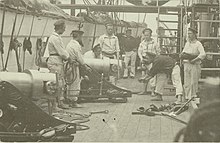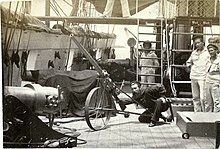SMS Nymphe (1863)
 Painting of the Battle of Jasmund by Willy Stöwer, depicting the Prussian squadron; Nymphe is at left, astern of Arcona
| |
| History | |
|---|---|
| Name | Nymphe |
| Namesake | Nymph |
| Builder | Danzig |
| Laid down | 25 January 1862 |
| Launched | 15 April 1863 |
| Commissioned | 20 February 1864 |
| Stricken | 21 July 1887 |
| Fate | Broken up, 1891 |
| General characteristics | |
| Class and type | Nymphe-class corvette |
| Displacement | ) |
| Length | 64.9 m (212 ft 11 in) (loa) |
| Beam | 10.2 m (33 ft 6 in) |
| Draft | 3.92 m (12 ft 10 in) |
| Installed power |
|
| Propulsion |
|
| Sail plan | Full ship rig |
| Speed | 12 knots (22 km/h; 14 mph) |
| Range | 1,250 nmi (2,320 km; 1,440 mi) at 12 knots (22 km/h; 14 mph) |
| Crew |
|
| Armament |
|
SMS Nymphe was the
Nymphe saw action during the
In 1871, Nymphe embarked on a major overseas deployment to the
.Design
The two Nymphe-class corvettes were ordered in the early 1860s as part of a program to strengthen the
Nymphe was 64.9 meters (212 ft 11 in)
Nymphe was armed with a battery of ten 36-pounder guns and six 12-pounder guns, all smoothbores mounted on the broadside. In 1869, these guns were replaced with seventeen, and later nineteen, rifled 12 cm (4.7 in) 23-caliber guns. Later in her career, these were reduced to nine guns.[2][3]
Service history
Nymphe was ordered on 23 July 1861, the first of the wooden
Second Schleswig War
Nymphe was
Battle of Jasmund

The next morning, at 07:30, Jachmann took his ships out of the mouth of the Oder, initially steaming east. Unable to locate any Danish warships, the Prussians turned west and, as they approached the island of Greifswalder Oie, lookouts aboard the ships spotted smoke to the northwest at about 13:15. The Prussians continued on toward the island of Rügen; off the Jasmund Peninsula, Jachmann's ships encountered Dockum's squadron.[9] There, with Arcona and Nymphe in the lead, Jachmann turned to engage the Danes; Loreley increased speed to join the two corvettes while Jachmann sent the gunboats to the coast of Rügen, where they could be used to cover his withdrawal. From further north, Dockum was awaiting the arrival of the steam frigate Tordenskjold.[10]
At 14:30, Arcona opened fire, targeting the frigate Sjælland; a few minutes later, after Sjælland closed to 1,500 meters (1,600 yd), Dockum turned his flagship to starboard and began firing broadsides at Arcona. Jachmann turned Arcona to starboard as well, having realized the strength of the Danish squadron. He failed to inform the captains of Nymphe and Loreley of his decision to withdraw, and they continued to steam east for several minutes before they conformed to his maneuver. At this time, Dockum shifted fire to Nymphe and scored several hits, including damage to her funnel that reduced her speed temporarily. Dockum attempted to overtake and cut off Nymphe and Loreley from Arcona, but Nymphe's crew was able to quickly repair the damage she had sustained, allowing her to increase speed, though she continued to take hits.[9]
Nymphe and Loreley came under heavy fire from the pursuing Danish squadron; at 16:00 Loreley broke off to the west toward Stralsund and Dockum allowed her to leave, preferring to continue after Jachmann's corvettes. Both sides continued to score hits on each other until they checked fire at around 16:45 as the range grew too long. By 18:00, Dockum ended the chase and steamed off to the east, allowing Jachmann to return to Swinemünde.
Jachmann made several more
Austro-Prussian and Franco-Prussian Wars
In early 1865, the Prussian Navy decided to send Nymphe and the gunboat
Nymphe} remained out of service until the outbreak of the
Bouët-Willaumez decided that the attack demonstrated that the large ironclads could not be effectively used close to shore, and that smaller, shallower-draft vessels would be necessary. He therefore took his ships away from Danzig, which Nymphe confirmed by a reconnaissance to
Overseas deployment

Nymphe remained in reserve through the end of the war, when she was recommissioned under command of KK Louis von Blanc on 1 June 1871 to relieve her sister ship Medusa, which had been blockaded by French warships in Japan during the war. Nymphe left Kiel on 25 July and made a stop in Cowes, where she was visited by the British royal family. She reached Rio de Janeiro, Brazil on 14 October, where she stayed for two weeks. During this period, some of her crew were in a local restaurant when a fight broke out between them and some pro-French civilians; the sailors were arrested by the Brazilian police, which prompted the German government to consider sending a squadron of warships to coerce their release. In response to the threatened naval deployment, the Brazilian authorities released the men, allowing Nymphe to proceed with her voyage on 27 October. While in South Africa, nine members of her crew deserted to join a diamond rush; Nymphe quickly left port on 22 November after the desertion to prevent any others from joining them.[15]
After crossing the Indian Ocean, she visited several ports in Australia and then sailed north into Oceania—the first German warship to reach the South Pacific—and visited several islands that had not yet been visited by German vessels.[16][17] These included the town of Levuka in Fiji in early March 1872, where Blanc negotiated a protection agreement, which was rejected by German chancellor Otto von Bismarck. On 15 March, Nymphe arrived in Apia in Samoa, where Blanc helped to settle disputes between German merchants and chiefs on the islands. She left the islands at the end of the month and arrived in Yokohama, Japan on 20 April, where she met the frigate Hertha, the other member of the East Asia station. Nymphe then began a tour of Japanese and Russian ports, including Nagoya, Japan, which had recently been opened to foreign ships, before stopping in Hong Kong on 25 December. Nymphe visited Singapore in March 1873, after which a large portion of her crew became ill. She then went to Borneo to enforce German demands for financial compensation for a German company. Nymphe then visited Jolo in the Sulu Archipelago, then part of the Spanish Empire, where Sultan Jamal ul-Azam requested that Germany sign a protectorate agreement, since he wished to declare independence from Spain. Blanc passed the request on to Berlin, where it was rejected by Bismarck.[16]
On 11 April, she returned to Singapore; Blanc and a contingent from the ship traveled overland to
Later career

Nymphe was recommissioned on 1 June for use as a training ship for Schiffsjungen (apprentice seamen). She initially embarked on a cruise in the Baltic with the brigs Undine and Musquito before carrying Prince Friedrich Karl of Prussia to visit the kings of Denmark and Sweden. She participated in a fleet review for now Kaiser Wilhelm I on 19 September. She moved to Danzig, where she was decommissioned for an overhaul on 15 October. This work was completed by late 1875, and she returned to service on 1 April 1876 for training ship duties. Nymphe embarked on a major training cruise to North and South America, ranging as far north as Halifax, Canada and as far south as Montevideo, Uruguay. While in Uruguay, she steamed up the Uruguay River to Paysandú, where a memorial for the German consul, who had been murdered several years earlier, was dedicated with military honors. The ship arrived back in Kiel on 10 September 1877, where she was decommissioned on the 27th.[18]
The ship was reactivated on 1 January 1878 to begin the next year's training routine. She began the overseas training cruise in mid-July, and it repeated the destination of the previous year's cruise, though this time she only went as far south as Rio de Janeiro. In January 1879, she stopped in several ports in Venezuela to protect Germans during a period of unrest in the country. She carried a Venezuelan government delegation from
On 3 April 1880, Nymphe was recommissioned and began training cruises in the Baltic. She began the overseas cruise on 12 July; on the way out, she stopped in
The ship was out of service owing to the fever until 26 February 1883, after which she visited numerous Greek ports; while in
Notes
- ^ Sondhaus, pp. 63, 66.
- ^ a b c Gröner, p. 85.
- ^ a b Lyon, p. 250.
- ^ a b c d Hildebrand, Röhr, & Steinmetz, p. 177.
- ^ Embree, p. 272.
- ^ Sondhaus, p. 76.
- ^ Sondhaus, pp. 75–76.
- ^ Embree, pp. 272–274.
- ^ a b Embree, p. 274.
- ^ Embree, pp. 275–277.
- ^ Embree, p. 278.
- ^ Hildebrand, Röhr, & Steinmetz, pp. 177–178.
- ^ a b Hildebrand, Röhr, & Steinmetz, p. 178.
- ^ Stenzel, pp. 583–584.
- ^ Hildebrand, Röhr, & Steinmetz, pp. 178–179.
- ^ a b c Hildebrand, Röhr, & Steinmetz, p. 179.
- ^ Dodson & Nottelmann, p. 26.
- ^ Hildebrand, Röhr, & Steinmetz, pp. 179–180.
- ^ a b c Hildebrand, Röhr, & Steinmetz, p. 180.
References
- ISBN 978-1-68247-745-8.
- Embree, Michael (2007). Bismarck's First War: The Campaign of Schleswig and Jutland 1864. Solihull: Helion & Co Ltd. ISBN 978-1-906033-03-3.
- ISBN 978-0-87021-790-6.
- Hildebrand, Hans H.; Röhr, Albert & Steinmetz, Hans-Otto (1993). Die Deutschen Kriegsschiffe: Biographien – ein Spiegel der Marinegeschichte von 1815 bis zur Gegenwart [The German Warships: Biographies − A Reflection of Naval History from 1815 to the Present] (in German). Vol. 6. Ratingen: Mundus Verlag. ISBN 3-7822-0237-6.
- Lyon, Hugh (1979). "Germany". In Gardiner, Robert; Chesneau, Roger; Kolesnik, Eugene M. (eds.). Conway's All the World's Fighting Ships 1860–1905. Greenwich: Conway Maritime Press. ISBN 978-0-85177-133-5.
- Sondhaus, Lawrence (1997). Preparing for Weltpolitik: German Sea Power Before the Tirpitz Era. Annapolis: Naval Institute Press. ISBN 978-1-55750-745-7.
- Stenzel, Alfred (1900). "The Fleet and the Coast". In von Pfiugk-Harttung, Julius Albert Georg (ed.). The Franco-German War, 1870–71. London: Swan Sonnenschein and Co. pp. 567–592. OCLC 3788640.
